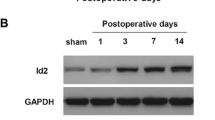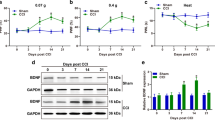Abstract
Neuropathic pain is elicited after a serious disorder of the nervous system and is along with the neural damage. It is usually chronic and challenging to treat. Transcription factor 4 (TCF4) is a key transcription factor of Wnt signaling system. Recent studies have shown that TCF4 interacts with β-catenin in the Wnt signaling pathway and coactivates downstream target genes in diverse systems. However, it is not well elucidated in the pathogenesis of neuropathic pain. In the present study, we investigated the role of TCF4 in the maintenance of neuropathic pain after chronic constriction injury (CCI) in rats. CCI induced persistent TCF4 upregulation in the dorsal root ganglion and spinal cord. Interestingly, TCF4 was mainly colocalized with neurons in the injured dorsal root ganglion and spinal cord on CCI day 7. Moreover, the expression patterns of β-catenin and glycogen synthase kinase-3β (GSK-3β) were parallel with that of TCF4 in vivo studies. Intrathecal injection of Wnt/β-catenin pathway inhibitor IWR-1-endo and TCF4 small interfering RNA (siRNA) significantly attenuated CCI-induced mechanical allodynia and heat hyperalgesia. The results suggest that TCF4 in the dorsal root ganglion and spinal cord is involved in the maintenance of CCI-induced neuropathic pain. Targeting TCF4 or Wnt/β-catenin signaling may be a potential treatment for chronic neuropathic pain.






Similar content being viewed by others
References
Archbold HC, Yang YX, Chen L, Cadigan KM (2012) How do they do Wnt they do?: regulation of transcription by the Wnt/beta-catenin pathway. Acta Physiol 204:74–109
Atcha FA et al (2007) A unique DNA binding domain converts T-cell factors into strong Wnt effectors. Mol Cell Biol 27:8352–8363
Attal N, Jazat F, Kayser V, Guilbaud G (1990) Further evidence for 'pain-related' behaviours in a model of unilateral peripheral mononeuropathy. Pain 41:235–251
Beildeck ME, Gelmann EP, Byers SW (2010) Cross-regulation of signaling pathways: an example of nuclear hormone receptors and the canonical Wnt pathway. Exp Cell Res 316:1763–1772
Bennett GJ, Xie YK (1988) A peripheral mononeuropathy in rat that produces disorders of pain sensation like those seen in man. Pain 33:87–107
Camac KS, Thompson FM, Cummins AG (2007) Activation of beta-catenin in the stem cell region of crypts during growth of the small intestine in infant rats. Dig Dis Sci 52:1242–1246
Chaplan SR, Bach FW, Pogrel JW, Chung JM, Yaksh TL (1994) Quantitative assessment of tactile allodynia in the rat paw. J Neurosci Methods 53:55–63
Chen J, Park CS, Tang SJ (2006) Activity-dependent synaptic Wnt release regulates hippocampal long term potentiation. J Biol Chem 281:11910–11916
Ciani L, Salinas PC (2005) WNTs in the vertebrate nervous system: from patterning to neuronal connectivity. Nat Rev Neurosci 6:351–362
Clevers H, Nusse R (2012) Wnt/beta-catenin signaling and disease. Cell 149:1192–1205
Costigan M, Scholz J, Woolf CJ (2009) Neuropathic pain: a maladaptive response of the nervous system to damage. Annu Rev Neurosci 32:1–32
Fernandez-Martos CM, Gonzalez-Fernandez C, Gonzalez P, Maqueda A, Arenas E, Rodriguez FJ (2011) Differential expression of Wnts after spinal cord contusion injury in adult rats. PLoS One 6, e27000
Fuerer C, Nusse R, Ten Berge D (2008) Wnt signalling in development and disease. Max Delbruck center for molecular medicine meeting on Wnt signaling in development and disease. EMBO Rep 9:134–138
Graham TA, Ferkey DM, Mao F, Kimelman D, Xu W (2001) Tcf4 can specifically recognize beta-catenin using alternative conformations. Nat Struct Biol 8:1048–1052
Hylden JL, Wilcox GL (1980) Intrathecal morphine in mice: a new technique. Eur J Pharmacol 67:313–316
Itokazu T, Hayano Y, Takahashi R, Yamashita T (2014) Involvement of Wnt/beta-catenin signaling in the development of neuropathic pain. Neurosci Res 79:34–40
Jensen TS, Baron R, Haanpaa M, Kalso E, Loeser JD, Rice AS, Treede RD (2011) A new definition of neuropathic pain. Pain 152:2204–2205
Kawasaki Y et al (2008) Distinct roles of matrix metalloproteases in the early- and late-phase development of neuropathic pain. Nat Med 14:331–336
Kikuchi A, Yamamoto H, Sato A, Matsumoto S (2011) New insights into the mechanism of Wnt signaling pathway activation. Int Rev Cell Mol Biol 291:21–71
Kurosaka H, Trainor PA, Leroux-Berger M, Iulianella A (2015) Cranial nerve development requires co-ordinated shh and canonical wnt signaling. PLoS One 10, e0120821
Lee HK, Chaboub LS, Zhu W, Zollinger D, Rasband MN, Fancy SP, Deneen B (2015) Daam2-PIP5K is a regulatory pathway for Wnt signaling and therapeutic target for remyelination in the CNS. Neuron 85:1227–1243
L'Episcopo F et al (2011) Reactive astrocytes and Wnt/beta-catenin signaling link nigrostriatal injury to repair in 1-methyl-4-phenyl-1,2,3,6-tetrahydropyridine model of Parkinson's disease. Neurobiol Dis 41:508–527
Liu F, Millar SE (2010) Wnt/beta-catenin signaling in oral tissue development and disease. J Dent Res 89:318–330
Marchetti B, Pluchino S (2013) Wnt your brain be inflamed? Yes, it Wnt! Trends Mol Med 19:144–156
Mastroiacovo F et al (2009) Induction of the Wnt antagonist, Dickkopf-1, contributes to the development of neuronal death in models of brain focal ischemia. J Cereb Blood Flow Metab Off J Int Soc Cereb Blood Flow Metab 29:264–276
Moalem G, Tracey DJ (2006) Immune and inflammatory mechanisms in neuropathic pain. Brain Res Rev 51:240–264
Okerlund ND, Cheyette BN (2011) Synaptic Wnt signaling-a contributor to major psychiatric disorders? J Neurodev Disord 3:162–174
Osada T et al (2011) Antihelminth compound niclosamide downregulates Wnt signaling and elicits antitumor responses in tumors with activating APC mutations. Cancer Res 71:4172–4182
Salinas PC (2012) Wnt signaling in the vertebrate central nervous system: from axon guidance to synaptic function Cold Spring Harb Perspect Biol 4
Shruster A, Eldar-Finkelman H, Melamed E, Offen D (2011) Wnt signaling pathway overcomes the disruption of neuronal differentiation of neural progenitor cells induced by oligomeric amyloid beta-peptide. J Neurochem 116:522–529
Takayama S, Rogatsky I, Schwarcz LE, Darimont BD (2006) The glucocorticoid receptor represses cyclin D1 by targeting the Tcf-beta-catenin complex. J Biol Chem 281:17856–17863
Tsuda M, Shigemoto-Mogami Y, Koizumi S, Mizokoshi A, Kohsaka S, Salter MW, Inoue K (2003) P2X4 receptors induced in spinal microglia gate tactile allodynia after nerve injury. Nature 424:778–783
Tsuda M et al (2011) JAK-STAT3 pathway regulates spinal astrocyte proliferation and neuropathic pain maintenance in rats. Brain J Neurol 134:1127–1139
von Hehn CA, Baron R, Woolf CJ (2012) Deconstructing the neuropathic pain phenotype to reveal neural mechanisms. Neuron 73:638–652
Wisniewska MB et al (2010) LEF1/beta-catenin complex regulates transcription of the Cav3.1 calcium channel gene (Cacna1g) in thalamic neurons of the adult brain. J Neurosci Off J Soc Neurosci 30:4957–4969
Woolf CJ, Mannion RJ (1999) Neuropathic pain: aetiology, symptoms, mechanisms, and management. Lancet 353:1959–1964
Woolf CJ, Salter MW (2000) Neuronal plasticity: increasing the gain in pain. Science 288:1765–1769
Yoo JH et al (2010) Lignans inhibit cell growth via regulation of Wnt/beta-catenin signaling. Food Chem Toxicol Int J Published Br Ind Biol Res Assoc 48:2247–2252
Zhang QG, Wang R, Khan M, Mahesh V, Brann DW (2008) Role of Dickkopf-1, an antagonist of the Wnt/beta-catenin signaling pathway, in estrogen-induced neuroprotection and attenuation of tau phosphorylation. J Neurosci Off J Soc Neurosci 28:8430–8441
Zhang YK, Huang ZJ, Liu S, Liu YP, Song AA, Song XJ (2013) WNT signaling underlies the pathogenesis of neuropathic pain in rodents. J Clin Investig 123:2268–2286
Zimmermann M (1983) Ethical guidelines for investigations of experimental pain in conscious animals. Pain 16:109–110
Acknowledgments
This work were supported by National Basic Research Program of China (973 Program, No. 2012CB822104), National Natural Science Foundation of China (31170766), Nantong City Social Development Projects funds (HS2012032), and a project funded by the Priority Academic Program Development of Jiangsu Higher Education Institutions (PAPD).
Author information
Authors and Affiliations
Corresponding authors
Additional information
Zhongling Xu and Yan Chen contributed equally to this work.
Rights and permissions
About this article
Cite this article
Xu, Z., Chen, Y., Yu, J. et al. TCF4 Mediates the Maintenance of Neuropathic Pain Through Wnt/β-Catenin Signaling Following Peripheral Nerve Injury in Rats. J Mol Neurosci 56, 397–408 (2015). https://doi.org/10.1007/s12031-015-0565-y
Received:
Accepted:
Published:
Issue Date:
DOI: https://doi.org/10.1007/s12031-015-0565-y




